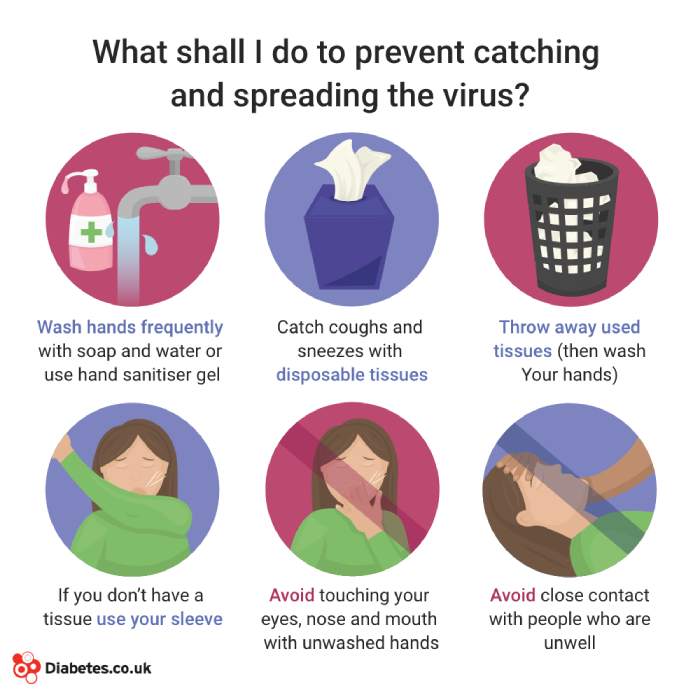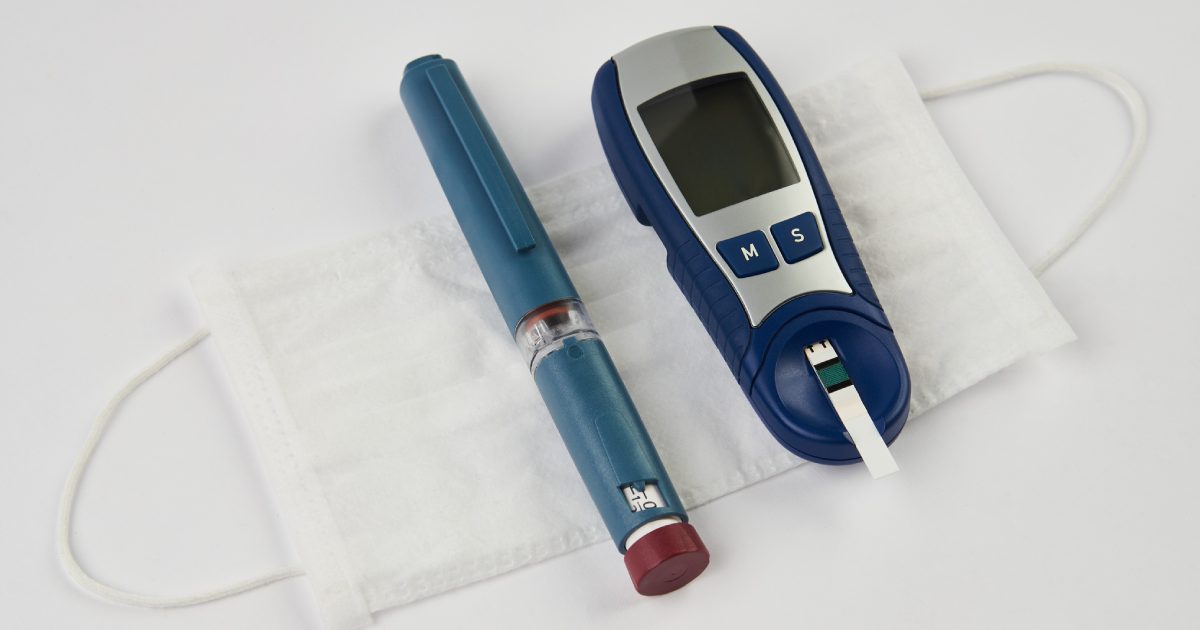This is a general guide to diabetes and coronavirus, pulling together all the key, current advice to create a help point about these two conditions and the way they interact.
What is COVID-19?
According to the World Health Organisation (WHO) COVID-19 is an infectious disease caused by a newly discovered type of coronavirus.
Most people infected with the COVID-19 virus will experience a mild to moderate respiratory illness (meaning that it affects the lungs and breathing) and will recover without requiring special treatment. Older people, and those with underlying medical problems like cardiovascular disease, diabetes, chronic respiratory disease, and cancer are more likely to develop serious illness [1].
COVID-19 spreads mainly from droplets spread by coughing or sneezing.
Symptoms of COVID-19 and coronavirus
In most cases, the main symptoms for COVID-19 are mild flu-like symptoms. The possible symptoms include a high temperature, dry cough, shortness of breath (trouble breathing), feeling tired, muscle aches, headaches and a new loss of taste and smell.
Symptoms can manifest a few days after a person is infected with the virus, with most cases occurring approximately 3-7 days after exposure. In some people, it can take up to 14 days for symptoms to appear. Some people may be infected but neither show symptoms or feel unwell. Others may develop more serious symptoms such as difficulty breathing and need to seek medical attention. [1,2].
How do I protect myself and my family?
 General guidance from the WHO on preventing the spread of COVID-19 includes frequent hand washing or using an alcohol-based rub, and not touching your face unless your hands are clean. The NHS also advises to cover your mouth and nose with a tissue or your sleeve (not your hands) when you cough or sneeze; put used tissues in the bin immediately and try to avoid close contact with people who are unwell.
General guidance from the WHO on preventing the spread of COVID-19 includes frequent hand washing or using an alcohol-based rub, and not touching your face unless your hands are clean. The NHS also advises to cover your mouth and nose with a tissue or your sleeve (not your hands) when you cough or sneeze; put used tissues in the bin immediately and try to avoid close contact with people who are unwell.
The current UK government guidance is to stay at home and this guidance is for everyone. Read all the latest government advice.
You are advised to only leave your home for the following reasons:
- Shopping for basic necessities; for example, food and medicine, which must be as infrequent as possible
- One form of exercise per day; for example, a run, walk, or cycle – alone or with members of your household
- Any medical need, including to donate blood, to avoid or escape risk of injury or harm, or to provide care or to help a vulnerable person
- Travelling for work purposes, but only where you cannot work from home
If you do need to go outside, then social distancing measures such as keeping 2 metres away from other people should be followed and you should wash your hands as soon as you get home.
The UK government has advised those at an increased risk of severe illness from COVID-19 to ensure they stringently follow the social distancing measures. This includes people with diabetes. You can read the current government social distancing guidance advice.
You can also read the NHS guidance for people at higher risk, such as people with diabetes.
Some people in the UK will be following shielding advice if they are extremely vulnerable. Under current guidance most people with diabetes do not need to shield unless they have conditions such as cystic-fibrosis related diabetes. These people will have been contacted by their GP or received a letter. See the government guidelines for the list of conditions this applies to and the advice to be following on shielding
What are my risks with diabetes and COVID-19?
People with diabetes are at a higher risk of developing a more severe illness with COVID-19, the same as with other viral infections such as the flu and pneumonia. This is the same for all types of diabetes and the way the illness affects people will vary from person to person [3].
One reason for this higher risk is possibly that the fluctuating or constantly elevated glucose levels in the blood can make the immune system less able to fight off infections. There is currently more research being carried out to fully understand why people with diabetes have a higher risk of a serious COVID-19 illness. A review of the current evidence by the Centre for Evidence Based Medicine (CEBM) from the 8 April 2020, concluded that there is not currently enough data to fully determine the reasons behind this increased risk [4].
When your body is fighting the infection, it is also harder to manage your diabetes, and you should be aware that your blood glucose levels could become raised for longer periods. If you have a diabetes sick day plan you should follow this to help you control your blood glucose levels.
What specific precautions can I take as a person with diabetes?
Precautions to take include following the general government guidance as outlined above e.g. basic hygiene and hand washing, social distancing, and avoiding close contact with those who are ill.
Specific precautions and advice include:
- Good glucose control is advised – if you routinely check your blood glucose levels at home to do this more frequently
- Keep hydrated
- If possible, to try and maintain a month’s worth of insulin, along with extra glucose monitoring and diabetes supplies.
- If you have a sick day plan you should follow this if you become ill
You should speak to your GP or diabetes team via phone if you have any concerns.
What if I think I have coronavirus?
If you, or someone in your household, has the symptoms then the current UK guidance is that the person showing symptoms should self-isolate for 7 days from when the symptoms started.
If you live with others and you are the first in the household to have symptoms of coronavirus (COVID-19), then you must stay at home for 7 days, but all other household members who remain well must stay at home and not leave the house for 14 days. The 14-day period starts from the day when the first person in the house became ill.
You can read more detailed guidance from the UK government.
If your symptoms are worsening and do not get better after 7 days, then you should access the NHS 111 online coronavirus service or call NHS 111 if you are not able to access the internet. Dial 999 for a medical emergency.
References:
[1] World Health Organisation. 2020. Coronavirus. [online] Available at: <https://www.who.int/health-topics/coronavirus#tab=tab_1> [Accessed 21 April 2020].
[2] Centers for Disease Control and Prevention. 2020. Coronavirus Disease 2019 (COVID-19) – Symptoms. [online] Available at: <https://www.cdc.gov/coronavirus/2019-ncov/symptoms-testing/symptoms.html> [Accessed 21 April 2020].
[3] Gupta, R., Ghosh, A., Singh, A,K. and Misra, A., 2020. Clinical considerations for patients with diabetes in times of COVID-19 epidemic. [online] Diabetes & Metabolic Syndrome: Clinical Research & Reviews. Available at: <https://doi.org/10.1016/j.dsx.2020.03.002> [Accessed 21 April 2020].
[4] Hartmann-Boyce, J., Morris, E., Goyder, C., Kinton, J., Perring, J., Nunan, D. and Khunti, K., 2020. Diabetes And Risks From COVID-19. [online] CEBM. Available at: <http://www.cebm.net/covid-19/diabetes-and-risks-from-covid-19/> [Accessed 21 April 2020].



